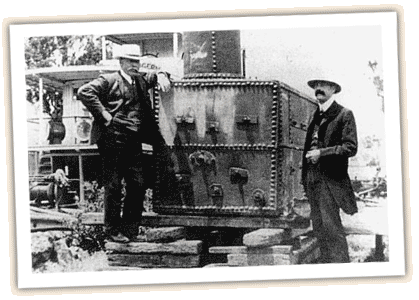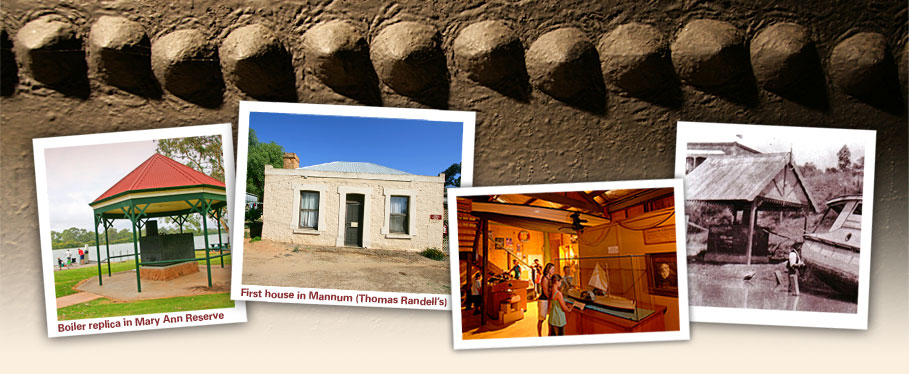William Richard Randell was only 13 years old when he arrived in Adelaide with his father. Whilst working at his father’s flour mill in Gumeracha, and looking after cattle on the station, he dreamed of building a paddle steamer.
Gold had been discovered in a creek near Bathurst by Edward Edmond Hardgraves and John Lister, and this encouraged river trading. More gold was discovered in Victoria, but William’s father thought that he and his brothers (Samuel, John, Thomas and Elliott) should stay with what they knew best and continue working at the flour mill.
Despite his father’s wishes, William and his brother Thomas George, engaged a carpenter and built the frame of a hull. This was taken by bullock dray thirty miles over the hills to the northern bank of Reedy Creek Station where it was completed. Timber for the completion of the boat, now called ‘Mary Ann’ after William’s mother, was cut from Red Gum in the Kenton Valley. The boiler was built by the blacksmith who worked at the flour mill.
The Mary Ann measured 55 feet long and 9 feet wide with a boiler 6 feet 9 inches long. It cost £1800. The beam engine was 7 to 8 horsepower with 10 inch cylinders made by Mr Claus Gehlkin, a German engineer at Hindmarsh. The boiler, being square, was an irregular design and proved to be very dangerous. Chains, with wedges beneath, were put round the boiler because it expanded alarmingly while under pressure.
The Mary Ann’s first trial run was on the 19th of February 1853, making it the first steamer on the River Murray. It went down river to John Baker’s Wall Station using steam and sail. The return journey (12 miles each way) took four hours. This allowed for the strong winds and river currents as well as a stop for fuel.
Heavily loaded with flour and other cargo intended for the goldfields, William Richard and his brothers were forced to turn back by a sand bar near Lake Bonney on their first trip up river in March 1853, trying again in August when the River rose. Also ready for the rise was Captain Francis Cadell, who with the financial backing from William Younghusband, had commissioned a new steamer in Sydney, the Lady Augusta, which was sailed through the Murray Mouth on 16 August 1853. Cadell had more than a year earlier come to an alternative agreement with the South Australian Government, where he was to receive subsidies and financial bonuses to open commercial navigation of the River. With an official party on board, including the Governor, the Lady Augusta with her Goolwa built barge Eureka, departed Goolwa on 25 August, passing the Mary Ann when she was three days from Swan Hill. While Cadell travelled 150 miles beyond Swan Hill before returning with a cargo of wool, Randell travelled further, reaching Maiden’s Punt (Echuca) at the junction of the Campaspe River, within 50 miles of the Bendigo diggings.
The boiler of the Mary Ann 1853 William Randell’s PS Mary Ann was the first steamer to trade on the Murray. The only surviving relic of this famous boat is its boiler.
“When the fire first started, the engineer, probably William’s brother Elliott, made a hasty retreat for the bank and from the shelter of a large gum tree waited until he could hear the regular beat of the pistons” The deficienciesof the Mary Ann were soon realised and in the face of superior competition it was scrapped in 1854. For a few years its hull was re-used as one half of the twin hulled Gemini. The old boiler was simply ditched in the river. About 40 years later, with the steamer industry at its peak, the historic value of the abandoned boiler was first realised. James Scott, an engineer working for William Randell, salvaged the boiler. Randell had told Scott that if he wanted to pull the boiler out it would have to be in his own time. |
Randell returned form his first trip up the river and developed his river trade business from the northern bank of Reedy Creek Station, near where the Randell Dry Dock is now situated. In this location, in 1854, he built his wharf, known as Darling Wharf. Behind the wharf, Randell built a goods shed for storing wool. This shed, better known as ‘The Wool Shed’ was the first building erected on the Mannum town site. From there the wool coming down river was carted to Adelaide by horse and cart – a slow trip in those days.

Over the next few years both pioneers, Randell and Cadell, were to explore the navigable limits of the river system. The success of these voyages opened a new trade. The next ten years was to see the dramatic increase and evolution in the river trade, while initially supplying goods to the diggings far cheaper than by bullock team from Melbourne, navigation of the rivers allowed formerly marginal wool growing areas access to cheap transport. Indeed the £4 or £5 a ton for a 1000 miles of transport was about what cartage by bullock team cost for less than a tenth of the distance.
Wool gradually increased to form the bulk of river cargoes. South Australian interests largely controlled this early period in the development of river transport.
The port proved to be a seed around which the Mannum community grew. New businesses were attracted to the transport node created by Randell’s initiative, and in 1869 he subdivided Section 114 of the Hundred of Finniss, which he called Port Mannum. High on a spur of the ridge at the back of the town, Randell constructed his home, Bleak House. As the land in the remainder of the Hundred was sold and cleared by farmers for agriculture, the town continued to grow during the 1870’s, attracting new industries such as the flour mill, begun by Benjamin Walker in 1876, and the blacksmith workshop of John and David Shearer in 1877.38
Captain Randell owned a total of 11 paddle steamers and six barges during his lifetime., during the late 1850s and mid 1860s, building: the Gemini – 1855, a twin hulled vessel, one of the hulls being from the Mary Ann; Bunyip – 1858, in partnership with John Taylor; Bogan – 1859 (constructed at Goolwa); Nil Desperandum – 1865 (built on the bank in front of the Bogan (Mannum) Hotel; and Ariel – 1867 (built at Goolwa). The Nil Desperandum was said to be built from the new hull that together with the Mary Ann’s hull previously formed the Gemini.
In the face of superior competition Australia’s first paddle steamer, Mary Ann, was scrapped in 1854. The old boiler was simply ditched in the river. In the late 1890s, with the steamer industry at its peak, the historic value of the abandoned boiler was first realised. James Scott, an engineer working for William Randell, salvaged the boiler. Since then it has been moved several times. It was first placed on the bank after being dragged from the river. In 1900 the Mary Ann boiler was taken to Adelaide as an exhibit at a Chamber of Manufacturers Exhibition. After William Richard’s death in 1911, a committee was formed and in 1912 it was placed under a shelter at the foot of Post Office Hill, in from of where the Lutheran Church now stands. The next move was to the Recreation Grounds (Mary Ann Reserve). Today the original boiler is displayed as an exhibit at the Mannum Dock Museum and a replica is displayed at the Reserve).
![]() Take the William Randell walk | Randell Dry Dock | Visit the Mannum Museum
Take the William Randell walk | Randell Dry Dock | Visit the Mannum Museum
